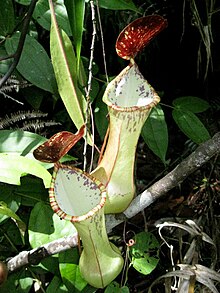Nepenthes eustachya
| Nepenthes eustachya | |
|---|---|
 |
|
| A pair of upper pitchers of N. eustachya | |
| Scientific classification | |
| Kingdom: | Plantae |
| (unranked): | Angiosperms |
| (unranked): | Eudicots |
| (unranked): | Core eudicots |
| Order: | Caryophyllales |
| Family: | Nepenthaceae |
| Genus: | Nepenthes |
| Species: | N. eustachya |
| Binomial name | |
|
Nepenthes eustachya Miq. (1858) |
|
| Synonyms | |
|
|
Nepenthes eustachya /nᵻˈpɛnθiːz juːˈstækiə/ is a tropical pitcher plant endemic to Sumatra, where it grows from sea level to an elevation of 1600 m. The specific epithet eustachya, formed from the Greek words eu (true) and stachys (spike), refers to the racemose structure of the inflorescence.
Nepenthes eustachya was probably first collected in February 1856 by Johannes Elias Teijsmann on the Sumatran coast near the port town of Sibolga. This specimen, Teijsmann 529, was designated as the lectotype of N. eustachya by Matthew Jebb and Martin Cheek in their 1997 monograph. It is deposited at the herbarium of the Bogor Botanical Gardens along with two isotypes.
Nepenthes eustachya was described in 1858 by Friedrich Miquel. In 1908, John Muirhead Macfarlane retained N. eustachya as a distinct species in his revision of the genus, titled "Nepenthaceae".
...
Wikipedia

